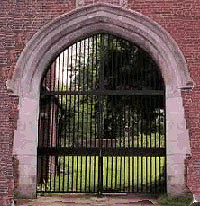|

The Basing House embroidery is a fine example of English raised or "stump" work dating to c1665. It is so called because of its possible association with Old Basing House. The motto of the Paulet family who owned the house during the 16th and 17th centuries was "Aymez Loyaulte" (love loyalty) and it is featured on the wall surrounding the house at the top left of the embroidery. It has been suggested that two of the characters in the design are from the Paulet family; the shadowy figures of a man, appearing from behind the left side of the canopy, and a woman behind the main crowned female character, could be the Paulets. The king sitting under the canopy is thought to be Charles II after his restoration to the throne.
The embroidery was purchased in 1991 because of its possible association with Old Basing House at the time of the Civil War. Grants from the National Arts Collection Fund and the Victoria and Albert Museum and the Friends of the Willis helped with its purchase.
From a technical point of view, the Basing House embroidery is remarkable. It is very finely worked and it uses much silver gilt thread in the design but which has now tarnished. Raised or stump work was fashionable in the 17th century especially from 1650-1680. The technique involves raising certain parts of the design to give a 3D effect by applying fabric or needlework segments over the top of padding. Shaped wooden moulds were used for faces and hands, as can be seen in the Basing House embroidery where silk fabric has disintegrated over time to reveal the form below. The background fabric is ivory silk and coloured silk thread, spangles and small pieces of mica have been used in the embroidery.
The embroidery is in a very fragile condition and needs careful handling. The colours have greatly faded and the raised elements, especially the acorns, are extremely vulnerable. When it first arrived in the Museums Service, it was carefully placed on a new backing by the then textile conservator, Rosie Smith. However, it is too fragile to display vertically and needs to be kept flat with the minimum of light (which can cause extensive damage to textile fibres) and the temperature and humidity controlled. To display the embroidery safely requires a specially designed case which is expensive. Yet this is necessary if the embroidery is to be enjoyed by future generations.
Alan Roach, the Chairman of the Friends said "We are working with other local history societies, including the Friends of Basing House, to ensure this rare and fragile example of a 400 year old embroidery finds its way home to be appreciated by the people of Basingstoke."
The Friends of the Willis are now looking for public support to raise funds to obtain a special climatically controlled display case for this locally significant and historically important embroidery. They must raise £3200 to bring this piece of Basingstoke's history home.
Donations to the Friends of the Willis can be made at the Willis Museum in the Old Town Hall, Basingstoke where the Friends have set up a treasure chest.
|



